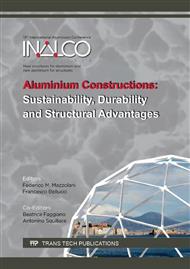p.3
p.13
p.22
p.35
p.41
p.47
p.53
p.59
p.65
Localized Corrosion Resistance of Dissimilar Aluminum Alloys Joined by Friction Stir Welding (FSW)
Abstract:
2XXX and 7XXX high strength aluminum alloys are the most used materials for structural parts of aircrafts due to their high strength/weight ratio. Their joining procedure is an engineering challenge since they present low weldability. Friction Stir Welding (FSW) is a joining technology developed in the early 90 ́s. It is a solid-state welding process, without the use of fillers or gas shield, that eliminates conventional welding defects and has been considered of great interest for application in the aircraft industry. FSW of aluminum alloys results in four regions of different microstructures, specifically: the base material (BM), the heat affected zone (HAZ), the thermo-mechanically affected zone (TMAZ), and the nugget zone (NZ). The complex microstructure of the weld region leads to higher susceptibility to localized corrosion as compared to the BM even when similar alloys are joined. The welding of dissimilar alloys in its turn results in even more complex microstructures as materials with intrinsically different composition, microstructures and electrochemical properties are put in close contact. Despite the great interest in FSW, up to now, only few corrosion studies have been carried out for characterization of the corrosion resistance of dissimilar Al alloys welded by FSW. The aim of this study is to investigate the corrosion behavior of aluminum alloy 2024-T3 (AA2024-T3) welded to aluminum alloy 7475-T761 (AA7475-T761) by FSW. The evaluation was performed in 0.01 mol.L-1 by means of open circuit potential measurements, polarization techniques and surface observation after corrosion tests.
Info:
Periodical:
Pages:
41-46
Citation:
Online since:
September 2016
Price:
Сopyright:
© 2016 Trans Tech Publications Ltd. All Rights Reserved
Share:
Citation:


